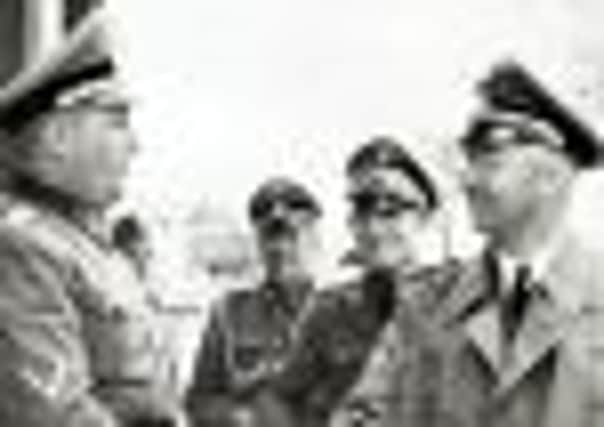Book reviews: The Commandant | Facing the Torturer


LAST month, barely noticed by the rest of the world, a 69-year-old man called Kain Guak Eav was sentenced to life imprisonment in Cambodia. Forty years ago, the former Khmer Rouge prison chief – commonly known as Comrade Duch – was responsible for the torture and murder of 12,000 men, women and children.
Go back another three decades – to 16 April 1947 – and another former prison governor was executed whose crimes were even greater. When Auschwitz, which he designed and where he was commandant, was running at peak capacity, he told the Nuremberg judges, “it had the capacity to get rid of 10,000 people in 24 hours”. Some 2.5 million people perished there.
Advertisement
Hide AdAdvertisement
Hide AdIt is easy to assume that such men as Hoess and Duch are different from the rest of us. Easy, but as these two books make clear, wrong.


The Commandant is an edited version of the chilling autobiography Hoess wrote in gaol in Krakow before his trial. But although he admits to his crimes, and makes no serious attempt to explain or excuse himself, the flyleaf is wrong to classify him as being “without remorse”. As a supervisor in a concentration camp earlier in his career, Hoess disliked the way prisoners were treated and admits that he “should have gone to Eicke or Himmler and explained that I was not suited for service because I had too much compassion for the prisoners. I did not have the courage to do this.” So he went with the flow and never protested. How often do the rest of us do just something similar – except the consequences of our cowardice are never as great?
Hoess had a normal if lonely childhood until his family moved to a larger town where he joined in with other boys and was part of a group. Certainly his boyhood obsession for washing was unusual, but his love of horses showed a gentler side. His father wanted him to be a priest – he remained a lifelong Catholic – but the local priest let him down by telling his parents something he had told him in the confessional.
The only clue to what he was to become was that “I always was able to get my way. If someone did something wrong to me, I did not rest until I got even.” After the French occupation of the Ruhr in 1922, he was sentenced to ten years in prison for leading his men to murder a Communist who had tipped off the authorities about a Nazi saboteur. He certainly knew what it was like to be on the receiving end of prison life.
Francois Bizot, a distinguished French ethnologist arrested by the Khmer Rouge on suspicion of being a CIA spy, cannot give us the same insight into the background of Duch. He clearly wishes he could, because he owes him his life. Without Duch’s intervention, he is certain that he would have been just another one of the Khmer Rouge’s victims: as it was, Duch was able to persuade his superiors to release him three months after his 1971 arrest.
Bizot worries about this compassionate gesture from a man who tortured and later murdered thousands of his own countrymen, including Bizot’s own two close associates. He fears that the relationship he struck up with his captor was unnatural. He also believes that he himself might have been capable of similar cruelty. When his father died, his mother wondered how she would cope with the family pet dog Sarah and Bizot solved her problem by taking the dog out and killing it.
In 1988, Bizot visited the deserted Tuol Sleng “factory of death” prison and spotted Duch in a photograph as the former commandant. Duch, every bit as much of a meticulous bureaucrat as Hoess, had left behind precise lists of the prisoners executed there and files from his time in charge. These showed his management style: his determination to attend executions as a good example to the men carrying out his orders: the rationale that “prisoners had to be beaten for reasons of national importance”.
Advertisement
Hide AdAdvertisement
Hide AdIn 2009, Bizet – who wrote about his experience of being the only westerner ever to be freed by the Khmer Rouge in his 2003 bestseller The Gate – gave evidence at Duch’s trial. He wanted to “reassert the monster’s humanity”. Nervous of appearing for the defence as it would discredit his academic reputation and too uncertain of his personal assessment of Duch, he was an impartial witness for the prosecution.
The latter part of Facing the Torturer contains a statement by Duch about his time as a prison supervisor and about his relationship with Bizot. The transcript of Bizot’s evidence is much more vivid than the agonising of his earlier commentary. He remains bewildered by “the instinctive sympathy” he had shown for this mass murderer.
Neither Hoess nor Duch admit to any enjoyment in what they did; it was their duty. Both were capable of family life and sympathy for the wrongly imprisoned. Both knew that what they were doing could lead to their own executions. Hoess never claims that what he did was acceptable and his only regret is not spending more time with his family.
Could their lives have been different or were they always set for a criminal life? Neither book can answer these questions. Both are remarkable insights into the lives of evil men.
Perhaps the last word should come from Bizot, talking about his daughter Helene, who was born after his release: “She too had to come to grips with reality: to accept the fact that the man to whom she can never be too grateful for having saved her father was also a killer”.
The Commandant
by Rudolph Hoess, edited by Jurg Amann
Overlook Duckworth, 112pp, £10
Facing the Torturer
By Francois Bizot
Ebury Publishing, 214pp, £16.99